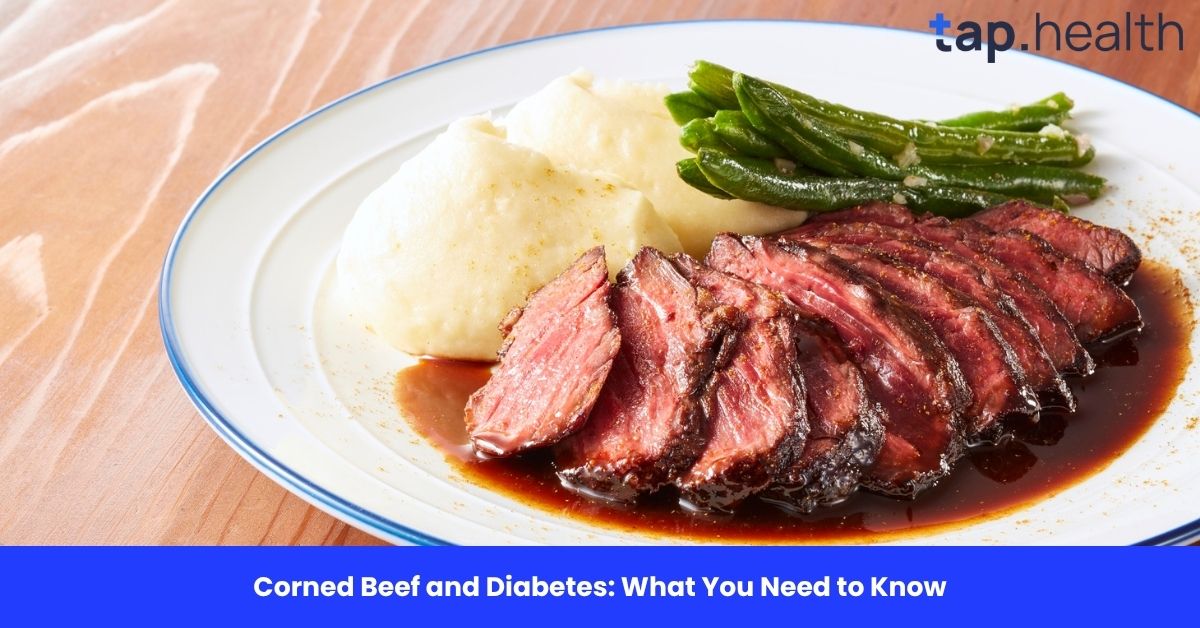If you have diabetes or are at risk, your diet plays a crucial role in managing blood sugar levels. Understanding what foods can either help or harm your blood sugar control is essential. One food that often sparks confusion is corned beef. Is it safe for individuals with diabetes? What are its nutritional implications? In this article, we will explore corned beef, its nutritional content, and how it fits into a diabetes-friendly diet.
By the end of this article, you’ll be equipped with the knowledge to make informed decisions about including corned beef in your meals, all while keeping your blood sugar levels in check.
What Is Corned Beef?
Corned beef is a type of salt-cured beef, typically made from brisket or round cuts. The term “corned” refers to the large grains of salt, called corns of salt, used to cure the meat. While it’s commonly associated with dishes like corned beef and cabbage or as a sandwich filling, it’s important to consider its nutritional content before adding it to a diabetes-friendly diet.
How Is Corned Beef Made?
Corned beef is made by brining beef in a solution of salt, water, and spices. This curing process gives corned beef its distinctive flavour. The beef is typically boiled after being cured, making it tender and easy to shred. Canned corned beef is also available, though it may have added preservatives and fat.
Types of Corned Beef
- Fresh Corned Beef: This is corned beef that has been brined but not cooked. It is usually sold as raw meat that needs to be boiled or roasted.
- Canned Corned Beef: A processed version of corned beef, often packed in its own fat and salt. This version is typically ready to eat, but it may contain more fat and sodium than fresh corned beef.
Nutritional Value of Corned Beef
Before determining whether corned beef is suitable for a diabetic diet, it’s essential to understand its nutritional profile. Below is the typical nutritional breakdown for a 3-ounce (85g) serving of cooked corned beef:
- Calories: 210–250 kcal
- Protein: 20–25g
- Fat: 15–20g
- Carbohydrates: 0g (Corned beef is free from carbohydrates)
- Sodium: 800–1,200mg (depending on preparation)
- Cholesterol: 60–70mg
High Sodium Content
One of the key concerns with corned beef is its high sodium content. A single serving can contain a significant portion of your daily recommended sodium intake, which can be problematic for people with diabetes who are also at risk for high blood pressure or heart disease.
Excessive sodium intake can lead to fluid retention, high blood pressure, and increase the risk of complications associated with diabetes, such as heart disease or kidney problems.
Protein and Fat
Corned beef is a good source of protein, which is essential for maintaining muscle mass and overall health. However, it is also relatively high in fat, especially saturated fat, which can contribute to heart disease if consumed in excess. Diabetics should be cautious about consuming too much saturated fat, as it may negatively affect insulin sensitivity and overall blood sugar control.
Is Corned Beef Safe for People with Diabetes?
While corned beef is not inherently dangerous for people with diabetes, it’s important to consume it in moderation and be mindful of its sodium and fat content. Here are a few things to consider:
1. Moderation Is Key
Due to its high sodium and fat content, it’s best to enjoy corned beef on occasion rather than as a regular part of your diet. Diabetic individuals should limit processed meats in general, as they may contribute to weight gain, insulin resistance, and increased risk of cardiovascular disease.
2. Balance Your Meal
If you decide to include corned beef in your diet, it’s important to balance it with other diabetes-friendly foods like vegetables, whole grains, and healthy fats. This helps to minimise the impact on blood sugar and ensures you’re getting a well-rounded meal.
For example:
- Pair your corned beef with a side of leafy greens or steamed vegetables to increase fibre intake, which helps regulate blood sugar.
- Choose a whole grain bread or wrap for a sandwich instead of refined options.
3. Consider Leaner Cuts
If possible, opt for leaner cuts of beef, or limit your consumption of higher-fat varieties. Canned corned beef, in particular, tends to have more added fat and sodium than fresh versions, making it a less optimal choice for people with diabetes.
Health Risks of Consuming Corned Beef for Diabetics
While corned beef can be enjoyed in moderation, there are certain risks for diabetics to be aware of:
1. High Sodium Intake
As previously mentioned, corned beef is high in sodium. Excess sodium can raise blood pressure, which is already a concern for many individuals with diabetes. Managing both blood sugar and blood pressure is critical for preventing complications like heart disease and kidney damage.
2. Increased Risk of Heart Disease
Diabetics are at a higher risk of developing heart disease. Since corned beef is high in saturated fat, frequent consumption could worsen cardiovascular health by increasing cholesterol levels. Saturated fat can contribute to insulin resistance, making blood sugar management more difficult.
3. Weight Gain
Processed meats like corned beef are calorie-dense, meaning they can contribute to weight gain if consumed excessively. Maintaining a healthy weight is key for managing diabetes, so it’s important to consume calorie-dense foods in moderation.
Best Ways to Include Corned Beef in a Diabetes-Friendly Diet
If you enjoy corned beef and want to include it in your diet, here are a few tips for making it more diabetes-friendly:
1. Control Portions
Limit your portion size to a small serving (about 3 ounces or 85 grams) to keep your calorie and sodium intake in check. You can pair it with a larger serving of vegetables or whole grains to create a well-balanced meal.
2. Opt for Leaner Cuts
When choosing corned beef, try to select leaner cuts with less visible fat. Trim any excess fat before cooking to reduce the fat content in your meal.
3. DIY Corned Beef
If you make corned beef at home, you can control the amount of sodium and fat used during the curing process. You can reduce the salt and experiment with low-sodium alternatives, which will make the dish more suitable for individuals with diabetes.
4. Avoid Canned Corned Beef
Canned corned beef often contains more preservatives, fat, and sodium than fresh options. Whenever possible, choose fresh corned beef that is made without excessive added ingredients.
Also read this : How Many Calories in 1 Pound of Ground Beef?
Key Takeaways
- Corned beef is high in protein but also contains significant amounts of sodium and saturated fat, which can pose challenges for individuals with diabetes.
- While corned beef can be enjoyed in moderation, it’s essential to balance it with low-sodium, high-fibre foods like vegetables and whole grains.
- Excessive sodium and saturated fat intake can increase the risk of heart disease, high blood pressure, and weight gain, all of which are concerns for people with diabetes.
- Lean cuts and homemade preparations are healthier alternatives to store-bought options, which often contain excess sodium and fat.
Frequently Asked Questions (FAQs) on Corned Beef and Diabetes
Q1: Is corned beef good for diabetics?
A1: Corned beef can be eaten by diabetics in moderation, but it should be balanced with other healthy foods. Due to its high sodium and saturated fat content, it’s best to consume it occasionally rather than regularly.
Q2: How much sodium is in corned beef?
A2: A 3-ounce serving of corned beef can contain anywhere from 800–1,200 mg of sodium, depending on the preparation. This is a significant portion of the recommended daily sodium intake.
Q3: Can I eat corned beef every day if I have diabetes?
A3: It’s not advisable to eat corned beef every day due to its high sodium and fat content. Moderation is key, and it’s important to balance it with other low-fat, low-sodium foods.
Q4: Is homemade corned beef better for diabetes?
A4: Homemade corned beef can be a healthier option because you can control the amount of salt and fat used in the curing process. This can make it a better choice for those managing diabetes.
Q5: What are the alternatives to corned beef for people with diabetes?
A5: Healthier alternatives to corned beef include lean cuts of chicken, turkey, or fish, which are lower in fat and sodium. You can also consider plant-based protein sources like tofu or legumes.
Q6: Can I eat corned beef if I have high blood pressure?
A6: It’s best to limit your intake of corned beef if you have high blood pressure due to its high sodium content. Opt for low-sodium alternatives or make corned beef at home with less salt.
Q7: Can corned beef be part of a heart-healthy diet?
A7: Corned beef is high in saturated fat, which may not be ideal for heart health. If consumed, it should be eaten sparingly and balanced with heart-healthy foods like vegetables, fruits, and whole grains.
Q8: How do I reduce the fat in corned beef?
A8: To reduce fat in corned beef, choose leaner cuts, trim visible fat, or use low-fat cooking methods like boiling or baking instead of frying.



